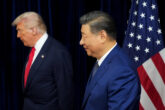December 19, 2024
How China’s Antitrust Tactics Undermine U.S. Tech Leadership
Less than a week after Washington ratcheted up its chip export controls, Beijing responded with a pointed escalation on Dec. 9: an antitrust probe into Nvidia, the United States’ leading chipmaker and a linchpin in artificial intelligence hardware. The investigation threatens to impose steep fines and disrupt Nvidia’s operations in China. By the end of the day that China announced the probe, Nvidia’s shares had fallen 4 percent. Far from a routine regulatory action, this move underscores China’s growing reliance on its competition authorities in the intensifying U.S.-China tech war. As the incoming Trump administration confronts this escalating rivalry, countering Beijing’s weaponization of antitrust should be a priority.
Antitrust law in the United States is guided by two foundational principles: protecting consumer welfare and promoting competition. China has a much different approach. While American antitrust doctrine is rooted in a strong rule-of-law tradition, China’s approach is driven by geopolitics. Under the pretense of fostering market competition, Beijing has increasingly weaponized antitrust policy to retaliate against U.S. trade actions. This trend has become particularly evident in response to U.S. semiconductor restrictions. Although China’s ability to counter these measures is constrained by its dependence on U.S. chip-making technology, Beijing has turned to its antitrust regulators as a means of striking back.
If the United States fails to address this threat, it risks not just losing ground in the technology race, but ceding control over the rules that govern it.
For the United States, the stakes could not be higher. Semiconductors are the foundation of modern technology, from frontier AI systems to advanced weaponry. If Chinese regulatory actions unfairly hinder American firms, the consequences for U.S. technology leadership could be severe. When deals fall through in China, they often collapse entirely, preventing American firms from conducting business as usual and undermining their growth and global competitiveness.
While the United States has countered other nefarious Chinese trade practices like IP theft and forced technology transfers, it largely overlooks China’s weaponization of antitrust, risking both U.S. tech leadership and the stability of global semiconductor supply chains. China’s weaponized enforcement in the semiconductor industry operates through two primary means: obstructing foreign mergers and acquisitions, and imposing conditions on U.S. firms that compel collaboration with Chinese companies. Left unchecked, both tactics threaten U.S. national and economic security.
Read the full article on Foreign Policy.
More from CNAS
-
Transatlantic Security / Technology & National Security
Look Before We Leap on Artificial IntelligenceThis article was originally published on The Dispatch. A debate about the role that artificial intelligence should and will play in society, and how it will affect humanity fo...
By Jon B. Wolfsthal
-
Technology & National Security
Caleb Withers on the Cybersecurity Frontier in the Age of AICaleb Withers, research associate at the Center for a New American Security, joins Kevin Frazier, the AI Innovation and Law Fellow at the University of Texas School of Law and...
By Caleb Withers
-
Technology & National Security
Prepared, Not ParalyzedExecutive Summary The Trump administration has embraced a pro-innovation approach to artificial intelligence (AI) policy. Its AI Action Plan, released July 2025, underscores t...
By Janet Egan, Spencer Michaels & Caleb Withers
-
Indo-Pacific Security / Technology & National Security
Sharper: Tech + ChinaRecent talks between President Donald Trump and Chinese Communist Party General Secretary Xi Jinping placed a spotlight on emerging technologies, from high-end chips to minera...
By Charles Horn & Sevi Silvia




